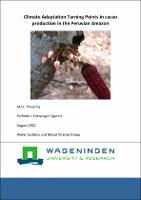Mostrar el registro sencillo del ítem
Climate adaptation turning points in cacao production in the Peruvian Amazon
| dc.contributor.advisor | Werners, Saskia E. | |
| dc.contributor.author | Korswagen Eguren, Stefanie Isabel | |
| dc.date.accessioned | 2021-08-20T17:34:33Z | |
| dc.date.available | 2021-08-20T17:34:33Z | |
| dc.date.issued | 2021-08 | |
| dc.identifier.citation | Korswagen, Stefanie (2021). Climate Adaptation Turning Points in cacao production in the Peruvian Amazon. MSc Thesis, Wageningen University & Research, Wageningen. 118 p. | es_PE |
| dc.identifier.uri | https://hdl.handle.net/20.500.12542/1236 | |
| dc.description.abstract | Cacao farmers in Peru aim to have an economic activity that delivers sustained income and allows them to achieve an acceptable quality of life. Their main challenges comprise drought, pests and diseases. For farmers, droughts of two weeks during the harvest season are critical, because they reduce the yield that could be harvested and commercialized. Drought stress also turns cacao trees more vulnerable to attacks of pests and diseases. The climate conditions where farmers perceive undesirable conditions were identified at a precipitation 32°C in the study area located in San Martin. Further critical climatic variables are: precipitation of the driest month, maximum temperature of the warmest month, as well as precipitation of the driest quarter and mean temperature of the driest quarter. In San Martin cacao already faces current maximum temperatures that exceed its optimum range and reach an average maximum of 32°C during the warmest month of the year. Climate projections show a clear increasing trend in temperature for the future. Models project an average of 34.8°C for 2050 under RCP 4.5 and up to 37.9°C by 2070 under RCP 8.5. Some localities in the study area also receive precipitation lower than 100 mm/ month during the driest month and the driest quarter under current conditions. Although there is variability among projections and RCP, models project a decrease in precipitation for the driest month and driest quarter under RCP 8.5. The suitability models show that the distribution range of cacao is mostly projected to remain suitable. Areas that may gain in suitability are located along a narrow NNW - SSE stripe along the Andes at higher elevations. In contrast, losses are projected along the Andean foothills and lower Amazon basin, especially towards 2070. Diseases follow a similar geographic trend. However, for some diseases the loss of suitable areas is prominent along large areas at the eastern Andean slopes and towards the lower Amazon. Insects’ responses vary under future scenarios. Carmenta sp. maintains large suitable areas in San Martin and Monalonion sp. gains in suitable areas under RCP 8.5. This work shows the added value of integrated approaches, especially by adding performance thresholds and incorporating stakeholders’ perceptions into ecological modelling. In addition, to the author’s knowledge, this work is the first to model cacao together with varied cacao pests and diseases in a single modelling exercise. There is a diversity of stakeholders in the Peruvian cacao sector, who require practical information on climate change impacts on cacao, its pests and diseases, as well as adaptation possibilities. Thanks to scientific platforms as well as stakeholder networks, there is an opportunity and momentum to share the results of this work. | es_PE |
| dc.format | application/pdf | es_PE |
| dc.language.iso | eng | es_PE |
| dc.publisher | Wageningen University & Research | es_PE |
| dc.rights | info:eu-repo/semantics/openAccess | es_PE |
| dc.rights | Reconocimiento - No comercial - Sin obra derivada (CC BY-NC-ND) | es_PE |
| dc.rights.uri | https://creativecommons.org/licenses/by-nc-nd/4.0/ | es_PE |
| dc.source | Repositorio Institucional - SENAMHI | es_PE |
| dc.source | Servicio Nacional de Meteorología e Hidrología del Perú | es_PE |
| dc.subject | Cacao | es_PE |
| dc.subject | Cambio Climático | es_PE |
| dc.subject | Modelos y Simulación | es_PE |
| dc.subject | Theobroma Cacao | es_PE |
| dc.subject | Moniliophthora Roreri | es_PE |
| dc.subject | Carmenta sp | es_PE |
| dc.subject | Agricultural Crops | es_PE |
| dc.subject | Agricultura | es_PE |
| dc.subject | Agroclimatología | es_PE |
| dc.title | Climate adaptation turning points in cacao production in the Peruvian Amazon | es_PE |
| dc.type | info:eu-repo/semantics/report | es_PE |
| dc.subject.ocde | https://purl.org/pe-repo/ocde/ford#4.01.01 | es_PE |
| dc.subject.ocde | https://purl.org/pe-repo/ocde/ford#1.05.10 | es_PE |
| renati.advisor.orcid | https://orcid.org/0000-0002-1705-4318 | es_PE |
| renati.author.dni | 70150053 | |
| renati.level | http://purl.org/pe-repo/renati/level#maestro | es_PE |
| renati.type | http://purl.org/pe-repo/renati/type#tesis | es_PE |
| dc.publisher.country | NE | es_PE |
| thesis.degree.discipline | Climate Studies | es_PE |
| thesis.degree.grantor | Wageningen University & Research | es_PE |
| thesis.degree.name | Master of Science in Climate Studies | es_PE |
| dc.identifier.url | https://hdl.handle.net/20.500.12542/1236 |









